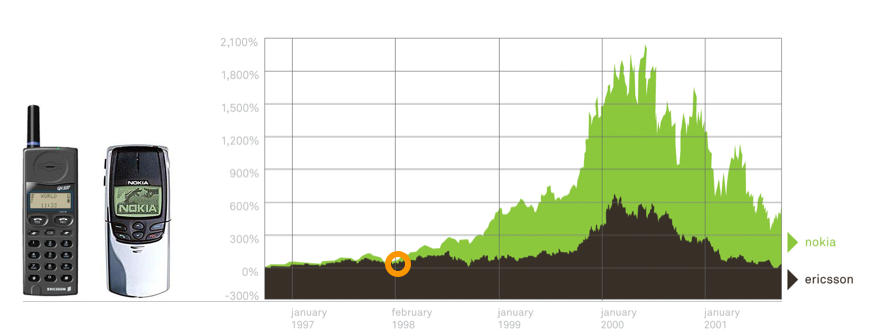Is this the end for Nokia, or a new beginning? Did Nokia ever get Design?
Written by Simon Clatworthy
Todays announcement of a strategic alliance between Nokia and Microsoft has prompted me to write something here, that I started thinking about a year (or so) ago, or even several years ago. Its about whether Nokia ever really understood design and the customer experience.
Many, many years ago, in 1998, Nokia launched the 8810. It was a phone that differentiated it from its main competitor, Ericsson, through design and experience. This was the perfect example of a product fitting into the experience economy, as described by Pine and Gilmore, at about the same time. No, the Nokia 8810 didnt have a good battery life compared to Ericsson. No, the Nokia didn’t have a good antenna and reception was poor. But, the Nokia 8810 had a design, experience and brand position that couldn’t fail. It was desirable, in the same way that the iPhone was desirable. Nokia had managed to marry self-identity, product design, interaction design and brand postion together into a fantastic whole. The phone was followed up by the “matrix” phone, and the rest is history. The graph below shows the effect on their relative stock market prices, and Nokia have lived off this ever since. In retrospect, I don’t think Nokia really understood what they had done, and they didn’t get time to reflect about it either – the dot com period exploded and they were sucked into the future, rather than continuing to invent it themselves.
Several years ago I was in Finland, just a few months after the first iPhone was launched, talking to several Nokia designers. It was very clear that these designers did not see the innovation that Apple had delivered in the iphone, and felt strongly that Nokia would not be challenged by this “temporary and ultimately failed” incursion into mobile phones by Apple. This shocked me at the time, and made me realise that Nokia-think had even pervaded the design department who should have seen the iphones desirability. This made me realise that although Nokia was often described as a design-focussed company, the reality was different. I dug a little deeper and found that product development at Nokia was pretty much out of date with contemporary strategic-design thinking. There was a great division between hardware design, and software design. For the 8810, this didn’t matter too much. The phone had limited functionality, and the software platform they had developed gave them a great interface that lasted over several years. They had made a really user-friendly platform, that could remain consistent over several generations of phones. And this made people trade from Nokia to Nokia, just to keep the platform and the user friendliness. However, as functionality started to change very quickly, this inability to design the holistic experience by integrating hardware and software, turned out to be their achilles heel.
Last year, Nokia launched the Nokia N8. This was Nokias stop-gap attempt to counter the runaway success of the iPhone. But, I was amazed to see how Nokia framed the N8. It was like a flashback to 1997, but the tables were turned. Suddenly, Nokia were advertising the phone on its functionality – megapixels and HD video rather than the experience this gives the customer. They had become Ericsson anno. 1997.
The experience was hardly mentioned in the adverts. The way the phone supported your personal identity, individuality and expression were secondary. This saddened me greatly, because it seemed very obvious that Nokia had never really understood design. They had had a superficial understanding of design as being the physical package rather than the whole, and it made the famous quote by Steve Jobs stand out in stark contrast:
“Design is not just what it looks like and feels like – Design is how it works.† Steve Jobs
So, I have begun to question whether Nokia really ever understood design. I think they got lucky in 1997. The market somehow made them feel that they were focussed upon design, whilst internally they were building an organisation that viewed design superficially. They separated software and hardware design and made good design almost impossible. As time went on, this separation became even more apparent through the adoption of symbian. The market wanted holistic experiences and Nokia was digging itself into an organisational structure that made them unable to deliver.
So, what of the recent announcement of a collaboration between Nokia and Microsoft? If you look at the trajectory described above, then it fits in very well. Nokia is still looking to separate software and hardware in terms of design. Responsibility for the customer experience will be where? The holistic concept that integrates hardware, software and service will be where? Desirability will come from where? I just cannot see how this can be anything other than a retrograde step in the long-term. However, I can understand that this makes sense in the short-term. Nokia gets an operative system that works and gets a short cut to a good user experience. However, I think that down the line, Nokia will find that they have now swapped places with their arch rival, Ericsson, in 1997. They are now the company that talks functions and not experiences. As Nokia already know, but perhaps have not understood, Desirability trumps functionality each and every time. This leaves them very open to competition from others that understand desirability. And as we know, there are a couple of those around.
